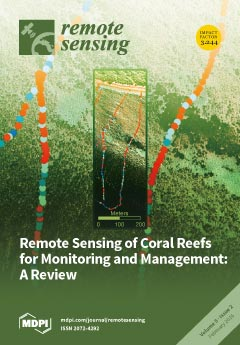Sentinel-2 (S2) earth observation satellite mission, launched in 2015, is foreseen to promote within-field decisions in Precision Agriculture (PA) for both: (1) optimizing crop production; and (2) regulating environmental impacts. In this second scope, a set of Leaf Area Index (LAI) derived from
[...] Read more.
Sentinel-2 (S2) earth observation satellite mission, launched in 2015, is foreseen to promote within-field decisions in Precision Agriculture (PA) for both: (1) optimizing crop production; and (2) regulating environmental impacts. In this second scope, a set of Leaf Area Index (LAI) derived from S2 type time-series (2006–2010, using Formosat-2 satellite) is used to spatially constrain the within-field crop growth and the related nitrogen contamination of surface water simulated at a small experimental catchment scale with the distributed agro-hydrological model Topography Nitrogen Transfer and Transformation (TNT2). The Soil Water Holding Capacity (SWHC), represented by two parameters, soil depth and retention porosity, is used to fit the yearly maximum of LAI (LAX) at each pixel of the satellite image. Possible combinations of soil parameters, defining 154 realistic SWHC found on the study site are used to force spatially homogeneous SWHC. LAX simulated at the pixel level for the 154 SWHC, for each of the five years of the study period, are recorded and hereafter referred to as synthetic LAX. Optimal SWHC
year_I,pixel_j, corresponding to minimal difference between observed and synthetic LAX
year_I,pixel_j, is selected for each pixel, independent of the value at neighboring pixels. Each re-estimated soil maps are used to re-simulate LAX
year_I. Results show that simulated and synthetic LAX
year_I,allpixels obtained from SWHC
year_I,allpixels are close and accurately fit the observed LAX
year_I,allpixels (RMSE = 0.05 m
2/m
2 to 0.2 and
R2 = 0.99 to 0.94), except for the year 2008 (RMSE = 0.8 m
2/m
2 and
R2 = 0.8). These results show that optimal SWHC can be derived from remote sensing series for one year. Unique SWHC solutions for each pixel that limit the LAX error for the five years to less than 0.2 m
2/m
2 are found for only 10% of the pixels. Selection of unique soil parameters using multi-year LAX and neighborhood solution is expected to deliver more robust soil parameters solutions and need to be assessed further. The use of optical remote sensing series is then a promising calibration step to represent crop growth within crop field at catchment level. Nevertheless, this study discusses the model and data improvements that are needed to get realistic spatial representation of agro-hydrological processes simulated within catchments.
Full article





